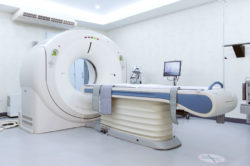 Having an MRI with contrast dye may put you at risk for gadolinium retention in the brain, kidneys, and other parts of the body.
Having an MRI with contrast dye may put you at risk for gadolinium retention in the brain, kidneys, and other parts of the body.
What Is an MRI?
A magnetic resonance image (MRI) uses magnetism to create a clear image of the tissues in the body. MRIs can provide extremely accurate pictures of the body and are relied on heavily in the diagnosis and treatment of diseases, including cancer.
Why Is Contrast Dye Needed in MRI?
A radiologist or doctor may request an MRI with contrast dye if highly detailed images are needed. According to Insider Radiology, about one in three MRI tests will include a contrast agent.
Contrast dyes are typically made of a heavy metal called gadolinium. During an MRI scan, gadolinium-based contrast agents are injected through an IV to improve the visibility of inflammation, tumors, blood vessels, and blood supply to organs.
Most patients will not experience any sort of sensation when the contrast agent is injected, but some may notice a cold sensation during injection. For the most part, injection side effects such as headache, nausea, or vomiting are rare.
Is It Safe to Get an MRI with Contrast Dye?
In most cases, having an MRI with contrast dye is safe. People with normal kidney function usually excrete 90 percent of the injected gadolinium from the body through urine within the first 24 hours. However, certain patients may experience some serious side effects, according to gadoliniumtoxicity.com.
In December 2017, the U.S. Food and Drug Administration (FDA) issued a requirement for a warning on all gadolinium-based contrast agents, including a new patient Medication Guide that provides educational information that every patient will be asked to read before receiving.
The warning alerts patients about the risk of gadolinium retention for months to years after injection.
The FDA told the American Society of Health-System Pharmacists that the agency hoped the new medication guide would “provide additional safety information, … so the patient can decide about receiving gadolinium.”
According to the FDA, the only known adverse effect associated with gadolinium retention is nephrogenic systemic fibrosis – a condition involving the thickening and darkening of large areas of the skin. The condition, which may cause skin to become “woody” in texture and appearance, has reportedly only been recorded in patients with kidney problems.
Before its announcement, the FDA only warned of gadolinium retention in patients with abnormal kidney function who may not be able to process the heavy metal out of their body via urine. The FDA announcement maintained the position that gadolinium retention “has not been directly linked to adverse health effects” in patients with normal kidney function. However, the agency noted that it has received reports of “adverse events involving multiple organ systems” in patients with normal kidney function.
Although gadolinium contrast agents do not contain warnings for patients with normal kidney function, adverse reactions may occur. It is up to patients and their doctors to determine if the use of gadolinium contrast agents outweighs the potential risks.
Are There Alternatives to Gadolinium-based Contrast Agents (GBCAs)?
Medical scientists have been investigating different, less toxic contrast agents for the past few years. Before delving into gadolinium alternatives however, it should be noted that GBCAs are available in two different forms: linear and macrocytic. The first type is essentially free gadolinium, which has a greater tendency to accumulate in brain and body tissues. The second type confines gadolinium inside of a molecule that is easier to pass out of the patient’s body.
In February of 2018, the National Institute of Health reported that a team at Massachusetts General Hospital had developed a contrast agent based on manganese, which is less toxic and more easily eliminated from the body.
Later that year, nanoscientists at Rice University demonstrated a contrast agent based on iron that performed better than available GBCAs.
Join a Free Gadolinium Toxicity Class Action Lawsuit Investigation
If you or a loved one developed gadolinium toxicity after having an MRI with gadolinium contrast, you may be eligible to file a gadolinium MRI lawsuit against pharmaceutical companies. Fill out the form on this page for a FREE evaluation of your eligibility.
ATTORNEY ADVERTISING
Top Class Actions is a Proud Member of the American Bar Association
LEGAL INFORMATION IS NOT LEGAL ADVICE
Top Class Actions Legal Statement
©2008 – 2026 Top Class Actions® LLC
Various Trademarks held by their respective owners
This website is not intended for viewing or usage by European Union citizens.
Get Help – It’s Free
Join a Free Gadolinium MRI Lawsuit Investigation
If you qualify, an attorney will contact you to discuss the details of your potential case at no charge to you.
PLEASE NOTE: If you want to participate in this investigation, it is imperative that you reply to the law firm if they call or email you. Failing to do so may result in you not getting signed up as a client or getting you dropped as a client.
E-mail any problems with this form to:
[email protected].
Oops! We could not locate your form.












